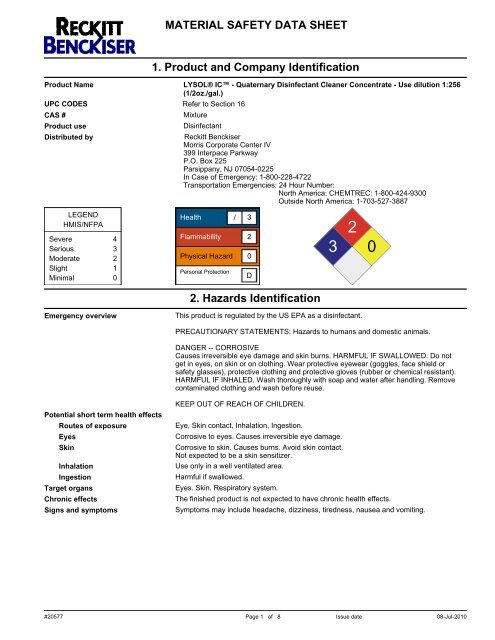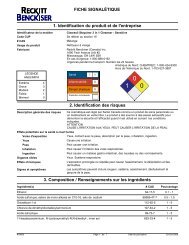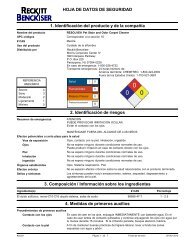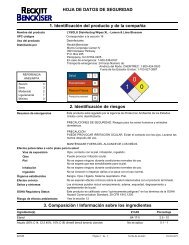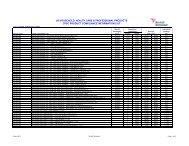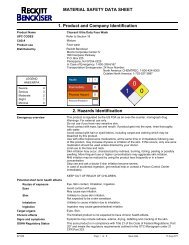Lysol I.C. Quaternary Disinfectant MSDS - Reckitt Benckiser
Lysol I.C. Quaternary Disinfectant MSDS - Reckitt Benckiser
Lysol I.C. Quaternary Disinfectant MSDS - Reckitt Benckiser
You also want an ePaper? Increase the reach of your titles
YUMPU automatically turns print PDFs into web optimized ePapers that Google loves.
..MATERIAL SAFETY DATA SHEET1. Product and Company IdentificationspaceProduct Name LYSOL® IC - <strong>Quaternary</strong> <strong>Disinfectant</strong> Cleaner Concentrate - Use dilution 1:256(1/2oz./gal.)spaceUPC CODES Refer to Section 16spaceCAS # MixturespaceProduct use <strong>Disinfectant</strong>spaceDistributed by<strong>Reckitt</strong> <strong>Benckiser</strong>Morris Corporate Center IV399 Interpace ParkwayP.O. Box 225Parsippany, NJ 07054-0225In Case of Emergency: 1-800-228-4722Transportation Emergencies: 24 Hour Number:North America: CHEMTREC: 1-800-424-9300Outside North America: 1-703-527-3887spaceLEGENDHMIS/NFPASevereSeriousModerateSlightMinimal43210HealthFlammabilityPhysical HazardPersonal Protection/320D23 0spaceEmergency overview2. Hazards IdentificationThis product is regulated by the US EPA as a disinfectant.PRECAUTIONARY STATEMENTS: Hazards to humans and domestic animals.DANGER -- CORROSIVECauses irreversible eye damage and skin burns. HARMFUL IF SWALLOWED. Do notget in eyes, on skin or on clothing. Wear protective eyewear (goggles, face shield orsafety glasses), protective clothing and protective gloves (rubber or chemical resistant).HARMFUL IF INHALED. Wash thoroughly with soap and water after handling. Removecontaminated clothing and wash before reuse.spacePotential short term health effectsspacespacespacespacespaceRoutes of exposureEyesSkinInhalationIngestionTarget organsspaceChronic effectsspaceSigns and symptomsKEEP OUT OF REACH OF CHILDREN.Eye, Skin contact, Inhalation, Ingestion.Corrosive to eyes. Causes irreversible eye damage.Corrosive to skin. Causes burns. Avoid skin contact.Not expected to be a skin sensitizer.Use only in a well ventilated area.Harmful if swallowed.Eyes. Skin. Respiratory system.The finished product is not expected to have chronic health effects.Symptoms may include headache, dizziness, tiredness, nausea and vomiting.#20577 Page 1 of 8Issue date08-Jul-2010
....spaceIngredient(s)3. Composition / Information on IngredientsCAS #PercentDidecyl Dimethyl Ammonium ChlorideEthylenediamine tetraacetic acidN-Alkyl (C14 50%, C12 40%, C16 10%) dimethyl benzyl ammonium chlorideOctyl dimethylamine oxideEthanolSodium hydroxideNot Applicable60-00-4Not Applicable2605-78-964-17-51310-73-27 - 132.5 - 102.5 - 102.5 - 101 - 2.51 - 2.5spaceFirst aid proceduresspacespacespacespaceEye contactSkin contactInhalationIngestionNotes to physicianspaceGeneral advice4. First Aid MeasuresHold eye open and rinse slowly and gently with water for 15-20 minutes. Remove contactlenses, if present, after the first 5 minutes, then continue rinsing eye.If on skin or clothing: Take off contaminated clothing. Rinse skin immediately with plentyof water for 15-20 minutes.Move person to fresh air. If person is not breathing, call 911 or an ambulance, then giveartificial respiration, preferably mouth-to-mouth if possible. Call a poison control center ordoctor for further treatment advice.Call a poison control center or doctor immediately for treatment advice. Have person sipa glass of water if able to swallow. DO NOT induce vomiting unless told to do so by apoison control center or doctor. Do not give anything by mouth to an unconsciousperson.Probable mucosal damage may contraindicate the use of gastric lavage.Appropriate treatment to help protect the affected person against circulatory shock,respiratory depression, and convulsion may be needed.If you feel unwell, seek medical advice (show the label where possible). Ensure thatmedical personnel are aware of the material(s) involved, and take precautions to protectthemselves. Show this safety data sheet to the doctor in attendance. Avoid contact witheyes and skin. Keep out of reach of children.Have the product container or label with you when calling a poison control center ordoctor, or going for treatment.5. Fire Fighting MeasuresspaceFlammable propertiesspaceExtinguishing mediaspacespaceSuitable extinguishing mediaUnsuitable extinguishing mediaProtection of firefightersSpecific hazards arising fromthe chemicalspaceProtective equipment forfirefightersspaceHazardous combustion productsspaceCombustible by OSHA criteria.Treat for surrounding material.Not availableNot availableExplosion dataSensitivity to mechanical impact Not availablespaceSensitivity to static discharge Not availableFirefighters should wear full protective clothing including self contained breathingapparatus.May include and are not limited to: Oxides of carbon. Oxides of nitrogen. Ammonia.Hydrogen chloride.6. Accidental Release MeasuresspacePersonal precautionsspaceMethods for containmentKeep unnecessary personnel away. Do not touch or walk through spilled material. Do nottouch damaged containers or spilled material unless wearing appropriate protectiveclothing. Keep people away from and upwind of spill/leak.Stop leak if you can do so without risk. Prevent entry into waterways, sewers, basementsor confined areas.#20577 Page 2 of 8Issue date08-Jul-2010
...spacespacespaceSkin and body protectionRespiratory protectionGeneral hygiene considerationsAs required by employer code.Emergency responders should wear impermeable clothing and footwear whenresponding to a situation where contact with the liquid is possible.Where exposure guideline levels may be exceeded, use an approved NIOSH respirator.Emergency responders should wear self-contained breathing apparatus (SCBA) to avoidinhalation of vapours generated by this product during a spill or other clean-upoperations.Use good industrial hygiene practices in handling this material. When using do not eat ordrink. Washing with soap and water after use is recommended as good hygienic practiceto prevent possible eye irritation from hand contact.9. Physical and Chemical PropertiesspaceAppearancespaceColorspaceFormspaceOdorspaceOdor thresholdspacePhysical stateClear.Amberaqueous solutionMild CharacteristicNot availableLiquidspacepH 7.2 - 8.2 @ 25°CspaceFreezing pointspaceBoiling pointspacePour pointspaceEvaporation ratespaceFlash pointspaceAuto-ignition temperaturespaceFlammability limits in air, lower, %by volumespaceFlammability limits in air, upper, %by volumespaceVapor pressurespaceVapor densityNot availableNot availableNot availableNot available159.99 °F (71.111 °C) TagliabueNot availableNot availableNot availableNot availableNot availablespaceSpecific gravity 0.99 - 1.01 @ 25°CspaceOctanol/water coefficientspaceSolubility (H2O)Not availableCompletespaceChemical stabilityspaceConditions to avoidspaceIncompatible materialsspaceHazardous decomposition productsspacePossibility of hazardous reactionsspaceComponent analysis - LC50Ingredient(s)10. Stability and ReactivityStable under recommended storage conditions.DO NOT MIX WITH BLEACH or use in conjunction with other household products.Excessive heat.Caustics. Acids. Oxidizers.May include and are not limited to: Oxides of carbon. Oxides of nitrogen. Ammonia.Hydrogen chloride.Hazardous polymerization does not occur.11. Toxicological InformationLC50Didecyl Dimethyl Ammonium ChlorideEthanolEthylenediamine tetraacetic acidN-Alkyl (C14 50%, C12 40%, C16 10%) dimethyl benzylammonium chlorideOctyl dimethylamine oxideSodium hydroxideNot available31623 ppm ratNot availableNot availableNot availableNot available#20577 Page 4 of 8Issue date08-Jul-2010
..spaceComponent analysis - Oral LD50Ingredient(s)LD50Didecyl Dimethyl Ammonium ChlorideEthanolEthylenediamine tetraacetic acidN-Alkyl (C14 50%, C12 40%, C16 10%) dimethyl benzylammonium chlorideOctyl dimethylamine oxideNot available3450 mg/kg mouse; 7060 mg/kg rat> 2000 mg/kg ratNot availableNot availableSodium hydroxideNot availablespaceEffects of acute exposureEyeCorrosive to eyes. Causes irreversible eye damage.spaceSkinCorrosive to skin. Causes burns. Avoid skin contact.Not expected to be a skin sensitizer.spaceInhalationUse only in a well ventilated area.spaceIngestionHarmful if swallowed.spaceSensitizationThe finished product is not expected to have chronic health effects.spaceChronic effectsThe finished product is not expected to have chronic health effects.spaceCarcinogenicityThe finished product is not expected to have chronic health effects.ACGIH - Threshold Limit Values - CarcinogensEthanol 64-17-5 A3 - Confirmed Animal Carcinogen with Unknown Relevance to HumansspaceMutagenicityspaceReproductive effectsspaceTeratogenicityspaceSynergistic MaterialsThe finished product is not expected to have chronic health effects.The finished product is not expected to have chronic health effects.The finished product is not expected to have chronic health effects.Not available12. Ecological InformationspaceEcotoxicityBulk quantities, if spilled, may be toxic to aquatic organisms, fish, birds and mammals.Control and clean up all exterior spills and prevent liquid from entering any streams,rivers, lakes and all other bodies of water.Ecotoxicity - Freshwater Algae DataEthylenediamine tetraacetic acid 60-00-4 72 Hr EC50 Desmodesmus subspicatus: 1.01 mg/LEcotoxicity - Freshwater Fish Species DataEthanol 64-17-5 96 Hr LC50 Oncorhynchus mykiss: 12.0-16.0 ml/L [static]; 96 Hr LC50 Pimephalespromelas: >100 mg/L [static]; 96 Hr LC50 Pimephales promelas: 13400-15100 mg/L[flow-through]Ethylenediamine tetraacetic acid 60-00-4 96 Hr LC50 Lepomis macrochirus: 34-62 mg/L [static]; 96 Hr LC50 Pimephalespromelas: 44.2-76.5 mg/L [static]Sodium hydroxide 1310-73-2 96 Hr LC50 Oncorhynchus mykiss: 45.4 mg/L [static]Ecotoxicity - Water Flea DataEthanol 64-17-5 48 Hr LC50 Daphnia magna: 9268 - 14221 mg/L; 24 Hr EC50 Daphnia magna: 10800mg/L; 48 Hr EC50 Daphnia magna: 2 mg/L [Static]Ethylenediamine tetraacetic acid 60-00-4 48 Hr EC50 Daphnia magna: 113 mg/L [Static]spaceEnvironmental effectsNot availablespaceAquatic toxicityNot availablespacePersistence / degradabilityNot availablespaceBioaccumulation / accumulation Not availablespacePartition coefficientNot availablespaceMobility in environmental media Not availablespaceChemical fate informationNot availablespaceWaste codes13. Disposal ConsiderationsNot available#20577 Page 5 of 8Issue date08-Jul-2010
.spaceDisposal instructionsspaceWaste from residues / unusedproductsspaceContaminated packagingDispose in accordance with all applicable regulations.CONTAINER DISPOSAL: Non-refillable container. Do not reuse or refill this container.Offer for recycling or reconditioning, or puncture and dispose of in a sanitary landfill, orincineration, or if allowed by state and local authorities, by burning. If burned, stay out ofsmoke.Not availableNot available14. Transport InformationspaceU.S. Department of Transportation (DOT)UN 1903, <strong>Disinfectant</strong>, Liquid, Corrosive, N.O.S.(Didecyl Dimethyl Ammonium Chloride, Alkyl DimethylBenzyl Ammonium Chloride), Class 8, PG III, LimitedQuantity Re-Classed as Consumer Commodity ORM-D.spaceTransportation of Dangerous Goods (TDG - Canada)UN 1903, <strong>Disinfectant</strong>, Liquid, Corrosive, N.O.S.(Didecyl Dimethyl Ammonium Chloride, Alkyl DimethylBenzyl Ammonium Chloride), Class 8, PG III, LimitedQuantity Re-Classed as Consumer Commodity / LimitedQuantityspaceIMDG (Marine Transport)UN 1903, <strong>Disinfectant</strong>, Liquid, Corrosive, N.O.S.(Didecyl Dimethyl Ammonium Chloride, Alkyl DimethylBenzyl Ammonium Chloride), Class 8, PG III, LimitedQuantity#20577 Page 6 of 8Issue date08-Jul-2010
.spaceIATA/ICAO (Air)UN 1903, <strong>Disinfectant</strong>, Liquid, Corrosive, N.O.S.(Didecyl Dimethyl Ammonium Chloride, Alkyl DimethylBenzyl Ammonium Chloride), Class 8, PG IIIspaceUS Federal regulations15. Regulatory InformationThis product is not known to be a "Hazardous Chemical" as defined by the OSHA HazardCommunication Standard, 29 CFR 1910.1200.CERCLA/SARA Hazardous Substances - Not applicable.Product Registration: Registered with EPA, EPA Reg. No. 47371-129-675U.S. - CERCLA/SARA - Hazardous Substances and their Reportable QuantitiesEthylenediamine tetraacetic acid 60-00-4 5000 Lb final RQ; 2270 kg final RQSodium hydroxide 1310-73-2 1000 Lb final RQ; 454 kg final RQU.S. - CWA (Clean Water Act) - Hazardous SubstancesEthylenediamine tetraacetic acid 60-00-4 PresentSodium hydroxide 1310-73-2 PresentspaceOccupational Safety and Health Administration (OSHA)29 CFR 1910.1200 hazardous YeschemicalspaceCERCLA (Superfund) reportable quantityEthylenediamine tetraacetic acid: 5000.0000Sodium hydroxide: 1000.0000spaceSuperfund Amendments and Reauthorization Act of 1986 (SARA)Hazard categoriesImmediate Hazard - YesDelayed Hazard - NoFire Hazard - YesPressure Hazard - NoReactivity Hazard - NospaceSection 302 extremelyNohazardous substancespaceSection 311 hazardous chemical YesspaceClean Air Act (CAA)Not availablespaceClean Water Act (CWA)Not available#20577 Page 7 of 8Issue date08-Jul-2010
.spaceState regulationsThis product does not contain a chemical known to the State of California to causecancer, birth defects or other reproductive harm.U.S. - California - 8 CCR Section 339 - Director's List of Hazardous SubstancesEthylenediamine tetraacetic acid 60-00-4 PresentSodium hydroxide 1310-73-2 PresentU.S. - Louisiana - Reportable Quantity List for PollutantsEthylenediamine tetraacetic acid 60-00-4 5000 Lb final RQ; 2270 kg final RQSodium hydroxide 1310-73-2 1000 Lb final RQ; 454 kg final RQU.S. - Massachusetts - Right To Know ListEthanol 64-17-5 TeratogenEthylenediamine tetraacetic acid 60-00-4 PresentSodium hydroxide 1310-73-2 PresentU.S. - Minnesota - Hazardous Substance ListEthanol 64-17-5 PresentSodium hydroxide 1310-73-2 PresentU.S. - New Jersey - Right to Know Hazardous Substance ListEthanol 64-17-5 sn 0844Ethylenediamine tetraacetic acid 60-00-4 sn 0876Sodium hydroxide 1310-73-2 sn 1706U.S. - New York - Reporting of Releases Part 597 - List of Hazardous SubstancesEthylenediamine tetraacetic acid 60-00-4 5000 Lb RQ (air); 1 lb RQ (land/water)Sodium hydroxide 1310-73-2 1000 Lb RQ (air); 100 lb RQ (land/water)U.S. - Pennsylvania - RTK (Right to Know) ListEthanol 64-17-5 PresentEthylenediamine tetraacetic acid 60-00-4 Environmental hazardSodium hydroxide 1310-73-2 Environmental hazardU.S. - Rhode Island - Hazardous Substance ListEthanol 64-17-5 Toxic; FlammableSodium hydroxide 1310-73-2 Toxic; FlammablespaceInventory statusCountry(s) or regionInventory nameOn inventory (yes/no)*United States & Puerto Rico Toxic Substances Control Act (TSCA) InventoryYesA "Yes" indicates that all components of this product comply with the inventory requirements administered by the governing country(s)space16. Other InformationDisclaimerThis product should only be used as directed on the label and for the purpose intended.To the best of our knowledge, the information contained herein is accurate. However,neither the above named supplier nor any of its subsidiaries assumes any liabilitywhatsoever for the accuracy or completeness of the information contained herein. Finaldetermination of suitability of any material is the sole responsibility of the user. Allmaterials may present unknown hazards and should be used with caution. Althoughcertain hazards are described herein, we cannot guarantee that these are the onlyhazards that exist.spaceFurther information36241-74983-5 - LYSOL® IC <strong>Quaternary</strong> <strong>Disinfectant</strong> Cleaner Concentrate - Usedilution 1:256 (1/2 oz./gal.) - 1 gal. - 366519spaceIssue date08-Jul-2010spaceEffective date01-Jul-2010spacePrepared by <strong>Reckitt</strong> <strong>Benckiser</strong> Regulatory Department 800-333-3899spaceOther informationFor an updated <strong>MSDS</strong>, please contact the supplier/manufacturer listed on the firstpage of the document.#20577 Page 8 of 8Issue date08-Jul-2010


